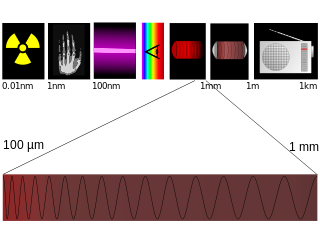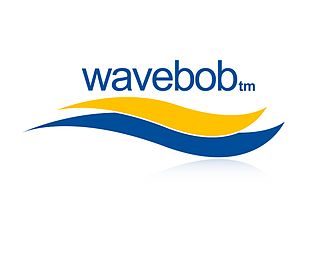Related Research Articles

Microwave is a form of electromagnetic radiation with wavelengths ranging from about 30 centimeters to one millimeter corresponding to frequencies between 1000 MHz and 300 GHz respectively. Different sources define different frequency ranges as microwaves; the above broad definition includes UHF, SHF and EHF bands. A more common definition in radio-frequency engineering is the range between 1 and 100 GHz. In all cases, microwaves include the entire SHF band at minimum. Frequencies in the microwave range are often referred to by their IEEE radar band designations: S, C, X, Ku, K, or Ka band, or by similar NATO or EU designations.

The High-frequency Active Auroral Research Program (HAARP) is a University of Alaska Fairbanks program which researches the ionosphere - the highest, ionized part of Earth's atmosphere.

The Norwegian University of Science and Technology is a public university in Norway and the largest in terms of enrollment. The university's headquarters campus is located in Trondheim, with regional campuses in Gjøvik and Ålesund.

The Norwegian Institute of Technology was a science institute in Trondheim, Norway. It was established in 1910, and existed as an independent technical university for 58 years, after which it was merged into the University of Trondheim as an independent college.
Ronald Newbold Bracewell AO was the Lewis M. Terman Professor of Electrical Engineering of the Space, Telecommunications, and Radioscience Laboratory at Stanford University.

Terahertz radiation – also known as submillimeter radiation, terahertz waves, tremendously high frequency (THF), T-rays, T-waves, T-light, T-lux or THz – consists of electromagnetic waves within the ITU-designated band of frequencies from 0.3 to 3 terahertz (THz), although the upper boundary is somewhat arbitrary and is considered by some sources as 30 THz. One terahertz is 1012 Hz or 1000 GHz. Wavelengths of radiation in the terahertz band correspondingly range from 1 mm to 0.1 mm = 100 µm. Because terahertz radiation begins at a wavelength of around 1 millimeter and proceeds into shorter wavelengths, it is sometimes known as the submillimeter band, and its radiation as submillimeter waves, especially in astronomy. This band of electromagnetic radiation lies within the transition region between microwave and far infrared, and can be regarded as either.

Wave power is the capture of energy of wind waves to do useful work – for example, electricity generation, water desalination, or pumping water. A machine that exploits wave power is a wave energy converter (WEC).

Ali Javan was an Iranian-American physicist and inventor. He was the first to propose the concept of the gas laser in 1959 at the Bell Telephone Laboratories. A successful prototype, constructed by him in collaboration with W. R. Bennett, Jr., and D. R. Herriott was demonstrated in 1960. His other contributions to science have been in the fields of quantum physics and spectroscopy.
Plasma stealth is a proposed process to use ionized gas (plasma) to reduce the radar cross-section (RCS) of an aircraft. Interactions between electromagnetic radiation and ionized gas have been extensively studied for many purposes, including concealing aircraft from radar as stealth technology. Various methods might plausibly be able to form a layer or cloud of plasma around a vehicle to deflect or absorb radar, from simpler electrostatic or radio frequency discharges to more complex laser discharges. It is theoretically possible to reduce RCS in this way, but it may be very difficult to do so in practice. Some Russian missiles e.g. the 3M22 Zircon (SS-N-33) and Kh-47M2 Kinzhal missiles have been reported to make use of plasma stealth.

Ronald William Prest Drever was a Scottish experimental physicist. He was a professor emeritus at the California Institute of Technology, co-founded the LIGO project, and was a co-inventor of the Pound–Drever–Hall technique for laser stabilisation, as well as the Hughes–Drever experiment. This work was instrumental in the first detection of gravitational waves in September 2015.

Wavebob was a wave energy converter which was in development between 1999 and 2013 when the company was closed owing to funding difficulties.
Michael E. McCormick is Corbin A. McNeill Professor Emeirtus of the Department of Naval Architecture and Ocean Engineering at the U. S. Naval Academy. He is one of the pioneers of modern wave energy research.

The history of metamaterials begins with artificial dielectrics in microwave engineering as it developed just after World War II. Yet, there are seminal explorations of artificial materials for manipulating electromagnetic waves at the end of the 19th century. Hence, the history of metamaterials is essentially a history of developing certain types of manufactured materials, which interact at radio frequency, microwave, and later optical frequencies.
Per Christian Møller Hemmer was a Norwegian physicist.
Kai Gudbrand Grjotheim was a Norwegian chemist.
A graphene antenna is a high-frequency antenna based on graphene, a one atom thick two dimensional carbon crystal, designed to enhance radio communications. The unique structure of graphene would enable these enhancements. Ultimately, the choice of graphene for the basis of this nano antenna was due to the behavior of electrons.
Hou Xun is a Chinese optical physicist, specializing in optoelectronics. He is a research professor and former director (1986–1995) of the Xi'an Institute of Optics and Precision Mechanics. He won the State Science and Technology Progress Award three times and was elected an academician of the Chinese Academy of Sciences in 1991.

Yakov Naumovich Feld — Soviet physicist who worked in the field of electrical engineering and antennas; laureate of A.S. Popov prize of the USSR Academy of Sciences (1986), doctor of technical Sciences (1947), Professor (1948).

Egil Sigurd Lillestøl was a Norwegian experimental elementary particle physicist.
References
- ↑ "Peaks and troughs of wave energy: the dreams and the reality – speaker biographies". royalsociety.org. Retrieved 24 October 2011.
- ↑ "The economics and technology of taming Atlantic waves". waveenergy.ie. Retrieved 22 December 2009.
- ↑ Drew, B.; Plummer, A. R.; Sahinkaya, M. N. (2009). "A review of wave energy converter technology". Proceedings of the Institution of Mechanical Engineers, Part A: Journal of Power and Energy . 223 (8): 887–902. doi:10.1243/09576509JPE782. S2CID 17186882.
- ↑ "Challenges for Wave Energy Technology". cesos.ntnu.no. Retrieved 22 December 2009.
- ↑ "Akademimedlemmer, Fysikk" (in Norwegian). Royal Norwegian Society of Sciences and Letters. Archived from the original on 9 October 2016. Retrieved 20 July 2016.
- ↑ "Medlemmer: FALNES, Johannes" (in Norwegian). Norwegian Academy of Technological Sciences . Retrieved 4 December 2012.